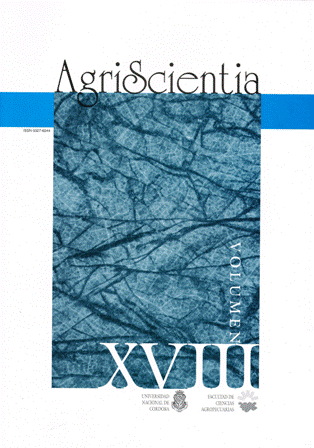Breeding of the cultivar "Tolse F.C.A." of Vicia dasycarpa (Ten.)
Main Article Content
Abstract
In the central semiarid region of the province of Córdoba, Argentina, there are not many fresh forage-producing annual legumes in the autumn-winter-spring period. The availability of species or cultivars of this family may allow the improvement of the soil nutrient level and of the quality of the cattle diet. One of the species that is known to produce fresh forage in good quantity and quality during this period with no irrigation is Vicia dasycarpa. With the aim of obtaining phenotypes adapted to the climatic conditions of the central region of Córdoba, a breeding program of a Vicia dasycarpa population R.P. N° 250 has been initiated using the adaptive response to the environmental conditions as the selection criterion. The selection characters were: tolerance to conditions of low precipitation and low temperature, growth vigor, cycle length, insect and disease resistance, and the weight of 1000 seeds. The constant selection of individual plants that showed a better genotype-environment adaptation determined a change in the genetic frequency of the selected characters in the phenotypes in relation to the original population. The results of this genetic advance are expressed in the new cultivar of Vicia dasycarpa named "Tolse F.C.A."
Article Details
Issue
Section

This work is licensed under a Creative Commons Attribution-ShareAlike 4.0 International License.
How to Cite
References
Al-Masri, M.R., 1998. Yield and nutritive value of vetch (Vicia sativa) - barley (Hordeum vulgare) forage under different harvesting regimens. Tropical Grasslands, vol. 32: 201-206.
Barnard, C., 1972. Register of Australian Herbage Plant Cultivar. Ed. CSIRO. Melbourne, Australia. 260 pp.
Bono, A.; D.E. Buschiazzo; M. Daitsh y H.E. Rocco, 1994. Vicia. Boletín de la Sociedad Rural de Jesús María, Nº 82: 22-23.
Cairnie, A.C. y J. Pérez Fernández, 1994. Vicia: un buen acompañante de los verdeos invernales. Informativo de Tecnología Agropecuaria para la Región Semiárida Pampeana, EEA INTA Anguil, La Pampa. Nº 99: 3.
Cairnie, A.C. y H. Castro, 1985. Una forma efectiva de mejorar la calidad del pasto llorón. Informativo de Tecnología Agropecuaria para la Región Semiárida Pampeana, EEA INTA Anguil, La Pampa. Nº 83: 4-6.
Covas, G., 1976. Cultivo asociado de pasto llorón y Vicia dasycarpa. Informativo de Tecnología Agropecuaria para la Región Semiárida Pampeana, EEA INTA Anguil, La Pampa. Nº 67: 2-3.
Goering, H.K. and P.J. Van Soest, 1970. Forage fiber analyses. Agriculture Handbook Nº 379. Agricultural Research Service, USDA.
McGregor, S.E., 1976. Insect pollination of cultivated crop plants. In: Clover and some relatives, Cap. 3: 1-6.
SMN., 1990. Registros meteorológicos del Observatorio Meteorológico de Córdoba.
Tilley, J.M.A. and R.A. Terry, 1963. Two-stage technique for the in vitro digestion of forage crops. J. Brit. Grassland Soc. 18: 104-111.
Vieyra, C.A.; J.C. Coraglio; E.F. Nienstedt y J.L. Bonvin, 1992. Producción de forrajes de especies del género Vicia a dos distancias de siembra. 4º Jornadas de Investigación en Ciencias Agropecuarias. Secretaría de Ciencia y Técnica. Facultad de Ciencias Agropecuarias. U.N.C.
Utomo, M.; W.W. Frye and R.L. Blevins, 1990. Sustaining soil nitrogen for corn using hairy vetch cover crop. Agronomy Journal, 82: 979-983.





